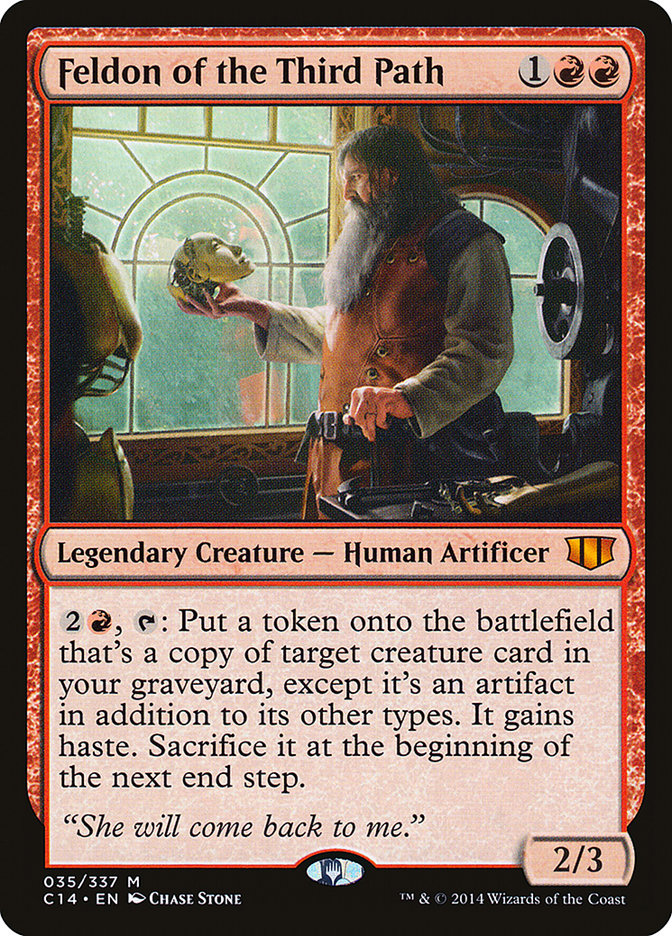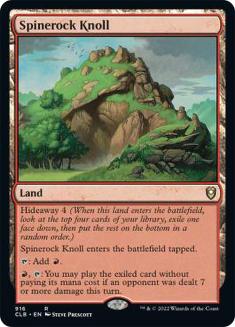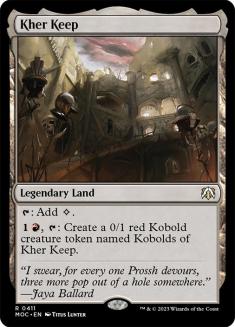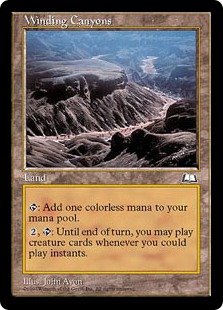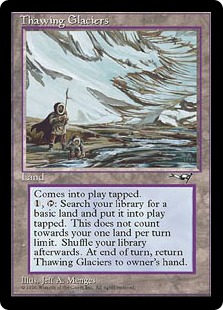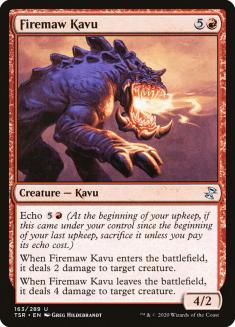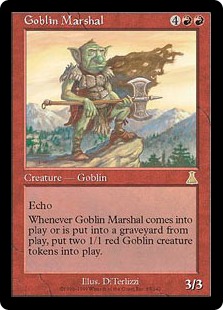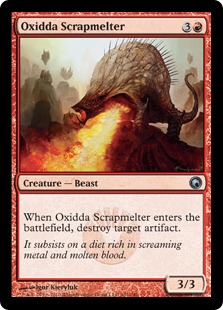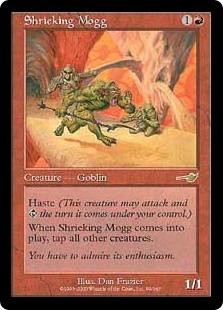|
Dear Azami, I was super excited to see the release of Feldon of the Third Path. Finally, a cool reanimate deck that isn’t black! I wanted to use a more reanimation-based strategy because Feldon allows you to abuse that a lot. The list I made is a bit expensive for my tastes, but I don’t know what to take out and what to replace it with. I would like it to be between $100-150. Here is the list: 30x Mountain Thanks for the help! – Brandon
|
So, Jess and I are hoping to work on each of the five new Commanders released in the five Commander 2014 decks, and it should come as no surprise at all that I would pick the red deck to work on first. Red is the worst color in Commander, everyone will tell you, but I tend to see it more as the most misunderstood color in Commander: good red decks exist, but they don’t come quite as naturally as you can get with some of the other colors. Everyone knows you can build a good green deck or blue deck without having to try particularly hard. Got draw spells, control elements, and some win conditions? Nice blue deck. Got ramp, recursion, and big creatures? Nice green deck. White and black have to work a bit harder, but they don’t start in too deep of a hole as far as keeping up with the Momirs is concerned – you can always just play a pile of tutors and then draw Necropotence, or build a deck with a ton of recursion elements and sweepers then put it away with Sun Titan. Red, though? Unless your commander can carry a lot of weight on its own, things can get a bit rough.
That’s where our newest red commander comes into play – there are only a few red commanders that build an entire theme around them and can hang as the center of a deck, but Feldon of the Third Path is definitely one of them. Red reanimation is a bit weird, actually, but it’s a powerful ability at a reasonable cost attached to a card that is allowed to be your Commander – we can run with this. I’m having a bit of a hard time figuring out where to start with my own build of the deck, mostly because I found myself wanting to start with Titania, Protector of Argoth instead, so this is as much for my benefit as it is for yours, Brandon. I’ve mostly been dreaming about cracking a fetchland and putting five power into play, why thank you, and not put very much thought at all to my inevitable interest in the red Commander cards even though I do love a good red deck. The hard part for Feldon of the Third Path, for me, is starting with a decklist that is not ‘just’ this year’s update of my old Godo, Bandit Warlord deck – getting a reader’s submission is the kick in the pants I needed to start exploring the Third Path.
Terra Firmer
A good manabase will provide you all the mana you need whenever you need it – but a great one will do that while giving you some extra utility as
well. Maybe a bit of card advantage, maybe a bit of extra defense, so long as it’s basically free and attached to a mana-producing land I’m always down for
anything interesting. You can add a lot of money here for some gains if you want to, since a key card-advantage card for a controlling deck is Crucible of
Worlds – but that requires adding the four red fetchlands, three on-color Panoramas, and the pair of ‘basic fetchlands’ (Evolving Wilds and
Terramorphic Expanse) so considering the stated budget, and the fact that red decks can’t tutor for key cards like the Crucible, the cost is high for something whose impact is
actually quite low.
You could also go Snow – snow-covered Mountains plus a Scrying Sheets – but again, cost to utility is relevant here. Sure, they’re basics, but they’re not
the basics you find at the land station at your local gaming store… at $1.50 each this adds up far too quickly. I would consider this more relevant if
you were already throwing money at the problem in order to fit in Crucible of Worlds, as then you could also play Mouth of Ronom and be able to
recur it from time to time, but with budget you’ve given here, we can spend it more wisely. I would be starting it here myself, but then it’s easy
for me – the budget’s not an issue, I have the fetchlands for playing Modern anyway, and for some reason I have held onto about twenty of each snow-covered
basic in case they feel right for a deck I’m working on. They aren’t auto-includes, though, even if there is seemingly no cost or downside to playing them –
I have a favorite full-art Zendikar Mountain as my go-to basic land, so “not being pretty enough” is almost a ‘cost,’ and there is also
the issue where people start to suspect you’re up to no good when you play Snow lands. One too many Commander players has pulled off the Snow basic plus
Extraplanar Lens trick by now, so even if you’re not playing the Lens, your Snow lands may nonetheless draw you random (and very passionate!) aggro from
your opponents.
As to the suggestions I am going to consider worthy of your limited budget to work with, first we’ll start with the question
of overall balance. I counted 98 cards in your deck, which means we have an extra slot that needs filling no matter what else we add in to the deck – and
your lands are a bit short of where I’d like them to be just in aggregate number. You don’t need too much mana over the course of a game since your deck
basically caps out around the six-mana mark, but I’ve found 37 lands to be approximately the right amount in order to draw three or so lands in your
opening hand – it’s up to your deck to go from there, generally, and adding two lands to your deck will significantly increase the certainty that you will hit
your early land drops on time. One we can just add directly, while the other needs to have the slot culled from another section in order to make the room.
Other than those two added slots, we’re going to cut six basic Mountains and upgrade them with fancy utility lands. I could honestly see cutting the
Haunted Fengraf instead of a Mountain if you aren’t solidly attached to it – that’s another land that gets considerably better with access to a Crucible, and between your deck already actively being able to use its graveyard as a resource and the choose-at-random nature of the card, I’m not in love
with it here even though I am generally quite happy to have it in a red deck’s manabase. I’ll be keeping it in the final build, but I wanted to flag it
here as something to consider for its relevance, as your opinion on the card based on playing it in your deck will be informed on actual experiences with
this build while my opinions are formed more arbitrarily based on red decks in general.
With those six slots cut and two more being added, we have room for eight new lands:
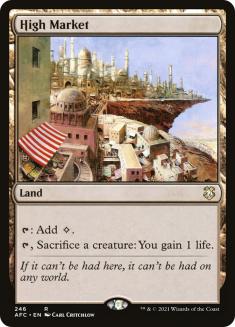
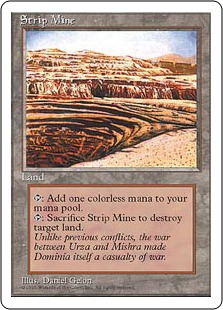
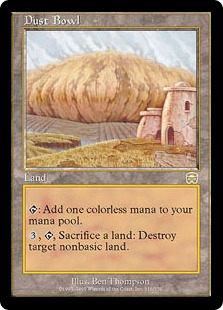
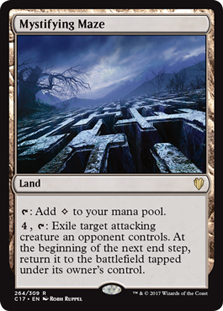

Adding High Market lets you maximize your beneficial sacrifice outlets at a reasonably low cost, while Strip Mine and Dust Bowl are added to acknowledge the
fact that your other cards are paying a bit of attention to opposing manabases – you can add the ability to interact with them without even playing a spell
if you want to. I tend to find that to be a good idea in Commander, and I play at least one such effect in each of my decks. Here, I think having two will be good
but more than that starts to be redundant while coming at the cost of dampening your access to red mana on-demand. If you add too many colorless lands, you
can (in fact) still get color-screwed in your mono-colored deck, which is truly sad indeed, so we’ll cut it off here even though we could have more cards that do this on the
pretty-cheap (Tectonic Edge, Ghost Quarter). One of them lets you repeat the effect if you need to, so you should still draw it about as plentifully as you
want without it negatively impacting your draws.
Kher Keep and Mystifying Maze both serve to potentially blunt an incoming attack when you don’t need them to tap for mana,
while Winding Canyons does all sorts of neat and interesting things that positively benefit pretty much any creature-based Commander deck. I have by now
written not just love poems to Winding Canyons but full love-articles, to the point where “add Winding Canyons” is a running joke here on Dear Azami
because it looks like I practically have a filter pre-set to automatically scan a decklist for Winding Canyons and swap one in if there isn’t one
already. That running joke could also have been a long-term speculative purchase if I’d ever had the presence of mind to do so – we’re getting pretty near to article #200 here
on Dear Azami and Winding Canyons has gone from $2.49 to $8.99 in that time, off of what could sarcastically be called the power of my own hot air alone.
Our last two additions give you some much-needed card advantage, which red is always incredibly lacking and can use anywhere you can get it. Spinerock
Knoll is a free spell at some point in the game, regardless of whether your deck is well-optimized to trigger its hideaway clause, while Thawing Glaciers
is a free land every other turn and is incredibly potent in a control shell – or just with that copy of Valakut, the Molten Pinnacle. Adding it helps make
it easier to actually cast the top end of this deck, so it’s well worth the expense and the card will always serve you well in some deck
in this format, regardless of whether or not you stick with this one.
The Spell’s The Thing
Typically I look at artifacts as half-mana and half-spell, since they’re usually supplementing your manabase, and thus they’re a nebulous part of the
deckbuilding process to me. But since I’m only making light cuts to
either the artifacts or the spells, we’ll consider them both at the same time. Artifacts first:
Out:
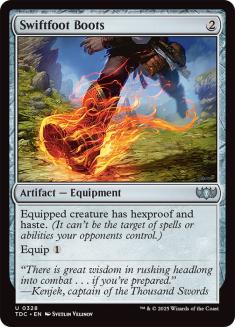
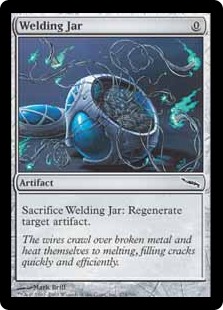
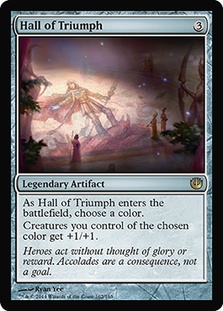
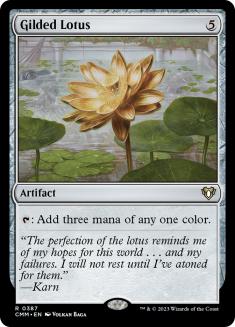
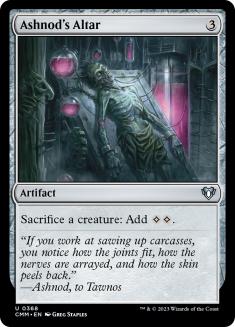
In:
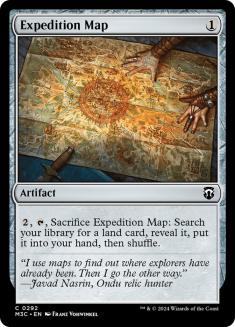
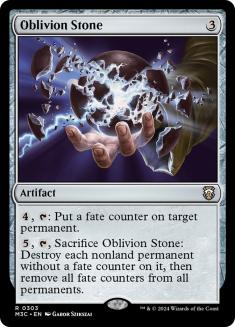
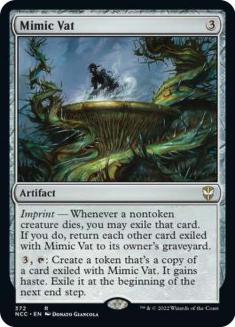
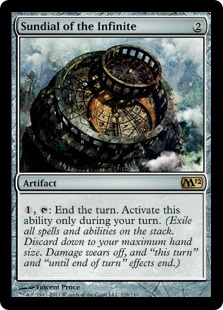

Expedition Map is here to give you an additional shot at any of your best lands, increasing each of their utility since now you can draw any of them twice
as often, while Mimic Vat is here because getting the right thing under the Mimic Vat is already something the deck seems optimized to do. Oblivion
Stone is here because there are some problem permanents that your deck might find incredibly difficult to remove from play, and while this deck is not very controlling, it does have some controlling elements to it, and red is the color least able to deal with the format’s most-powerful card type:
enchantments. That it also helps serve as a sweeper against aggressive decks or just against boards that aren’t going your way is a big plus too, as is its ability to give preferential treatment to your side of the board if you have enough time to plan around it.
Our last addition is almost “too cute,” but considering that Feldon includes a time-based trigger that you can skip past with Sundial of the Infinite, I
think it will do good work here. Feldon doesn’t actually reanimate a dead creature, after all, he creates a token that is merely constructed to look like
it – there’s a whole story in the card… its art, the ability, and the quote too… telling us about what he is trying to attain with these simulacra he keeps building. With Sundial of the Infinite it becomes possible to start keeping these token creatures around permanently and building up an army, not just profiting from some fleeting ephemera. The leaves-play trigger will need to
be allowed to go on the stack if you want to pull this trick off – merely ending your turn during your second main phase doesn’t break the sacrifice
condition, even though you’ve skipped the end step that seemed like was initially being discussed – but once you’ve bypassed the trigger you’ll get to keep
your token forever and can really start to profit from your Commander’s unique qualities. There’s enough play here just with your Commander that
including it does something interesting, but it’s worth noting that interesting stuff can happen with the Sundial just by having it in play – sometimes
there’s an end-of-turn card drawing spell being kept in check by your nifty timekeeping device, and other times you’ll attack with the team only to find
combat not going your way for one reason or another. You can’t respond to the Sudden Spoiling, after all, but you can look down at your watch and realize it’s time to be somewhere else –
the Sundial can keep opposing responses in check if you’re willing to forego a bit of damage in order to keep the team intact.
Now for the spells:
Out:
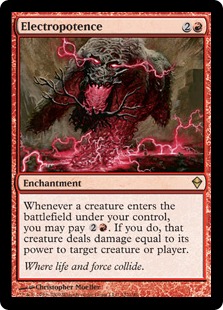
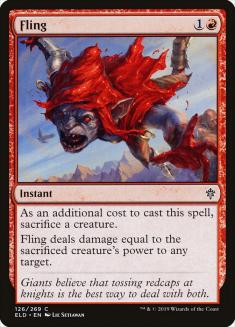
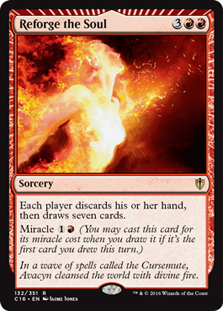
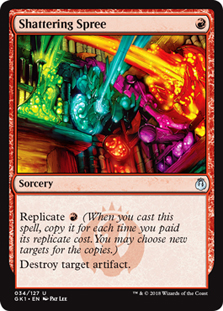
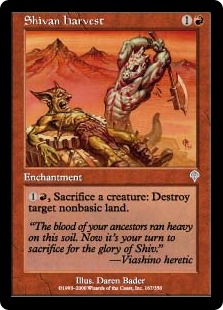
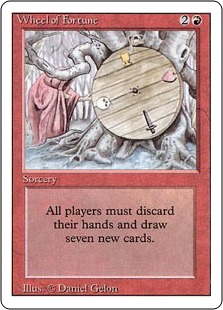

The draw-sevens just aren’t as good as they appear to be since you draw seven cards but so does each and every single opponent – at a four-player table
that means your seven fresh cards will have to grind out past 21 opposing cards. It’s just not as good a deal as it sounds, and not worth relying on no matter how much red wants card drawing effects. You do need draw effects to still have relevance during the late game, but these are not the cards that will help you do that. A player with no cards in
hand has no surprises for the table and has nothing they can do that isn’t just sitting right there in front of everybody, so we definitely want to keep
the cards flowing, but this is the wrong way to try and keep cards flowing to your hand.
Fling and Shattering Spree can both be reasonably upgraded here, while I am just not seeing Electropotence as being particularly critical – Warstorm Surge
lets you get the trigger by spending the extra three mana once, not every time, and this ability isn’t that relevant to what you’re trying to
accomplish anyway. As for Shivan Harvest, I like having a sacrifice outlet so we can put tokens to work and help make sure we can access the right
enters-the-battlefield triggers at the right time, but I’m less sold on this deck needing to actually invest a spell into pressuring opposing manabases.
This ability was shifted over to the manabase via adding that Dust Bowl and the sacrifice outlet was shifted over via adding that High Market, plus having some LD available is otherwise reasonably present in your creature base so we don’t
need an enchantment letting us exchange creatures for opposing lands even if the sacrificed creature was just living on borrowed time. This isn’t where the focus is, and I don’t think this is where it wants to be either.
In:
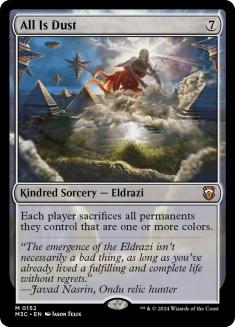
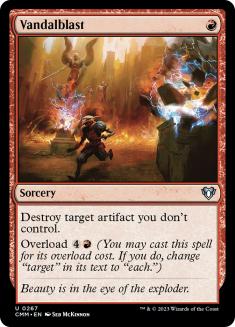
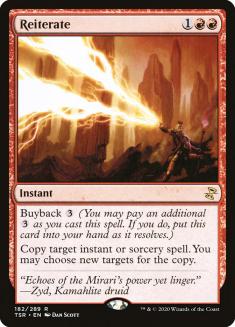
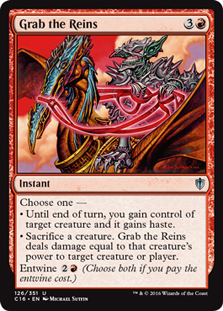

First off, we’ll note that we’ve added back in three fewer cards than we’ve cut – one became a land, so that means the last two slots must be moving over
to the creature base when we get to balancing it all out at the end. Vandalblast may not be as hard to counter as Shattering Spree, but it absolutely gets
the job done, and it has a few corner-case advantages of its own.
Problem cards you can’t target are a well-worn difficulty here in Commander-land, and an overloaded Vandalblast just does not care. All is Dust is
added for the same reasons as Oblivion Stone was, and possesses much of the same salutary benefits – enchantments all have colored mana symbols, after
all, so this will remove all of them from play plus most creature-based problems barring Affinity-esque threats. It’s also hard to play around or defend
against since it forces sacrifice, not destruction, and thus it is one of the best there is at what it does (and what it does ain’t nice).
Grab the Reins can be Fling if you want it to be but it can be so much more than that if you need it to be, so we’re upgrading a weak trick card for a very
strong one that does all sorts of odd things to combats if you get a little creative. And Reiterate is here mostly because it’s incredibly potent and
shifts what your opponent can actually do during the course of a game, generally in your favor – it’s not necessarily in keeping with the deck’s theme, but
it does help advance the deck’s objectives, and can be used to push cards through countermagic, hijack opposing Insurrections, and so much more if you
apply it cleverly. Just remember that the first time you use it will be the last time the opponent doesn’t play around it, and saving it for just the right
moment regardless of whether it has buyback can give you a tactical advantage even if you aren’t getting the card advantage it could offer you by
borrowing others’ spells.
Creature Feature
Feldon is all about what he can build. The quality and diversity of your dead former compatriots is key, and you’ve got an excellent mix here that should
give you a lot of options once they’re dead and play very well while they’re still alive too. Most of the cards I’m cutting here are the third- or fourth-best way to riff on the same theme, as the rest of your cards are things that work with Feldon but aren’t particularly interesting
when they do so, i.e. “Hamletback Goliath gets bigger thanks to resurrecting my best creature!” Sure, that’s true, but that doesn’t mean it’s worth seven
mana and a card just to get a big creature that gets bigger while you do your thing. The thing you’re doing is much more important than the
incidental monster, even if it would make a good story if you were able to attack someone to death with a huge Giant because
you used Feldon as a combat trick. (Or at least it’s a good story till people point out that it’s an on-board trick.) We’re going to focus on creatures that have spell-like abilities and trust that after a few turns of gaining an
advantage, you’ll have found some way to kill your opponent.
Out:
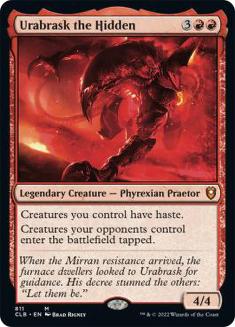
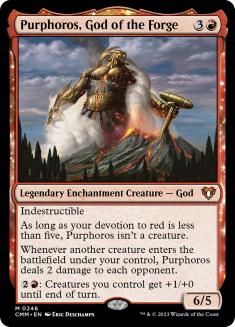
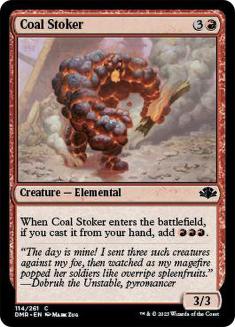
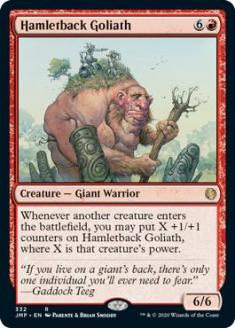
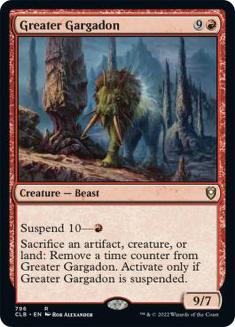

Coal Stoker’s ability only works when it comes from your hand, so I suspect it isn’t even the card you wanted for this job – that would be Priest of
Urabrask – but the job in question was one I disliked anyway, which seemed to be completing a corner-case infinite combo alongside Nim Deathmantle and
Ashnod’s Altar. The Altar had gotten cut because I distrust it everywhere I see it, and generally I dislike the job it tries to accomplish as a sacrifice
outlet. The Coal Stoker slot wasn’t really pulling its weight here while Shrieking Mogg was cute to
reanimate during an opponent’s combat step, but you can already do that with Thundermare and potentially have a non-embarrassing creature while you’re at
it. I don’t think we need to double up that particular effect if it requires playing such a weak card to do so.
Goblin Marshal makes tons of tokens, sure, but likewise is a weak card – you get pretty much the same effect from Siege-Gang Commander and way more
besides, pay one less mana up-front and never have this awful six-drop asking you to pay twice for it. Firemaw Kavu likewise has the
expense issue plaguing it, though here at least the echo is intended to be a way to kill another creature instead of just get a couple of goblins, but as
far as creature removal goes you can do a lot better with only a little bit of cost to do so. Oxidia Scrapmelter was cut because I think you
need one less of this effect, not because we’re going to specifically upgrade it, while Greater Gargadon’s utility as a sacrifice outlet was not as needed at this point and we can just free up the slot.
Hamletback Goliath gets cut for just being a dork, while Purphoros is cut because it’s neat but not actually particularly relevant to our
interests here. Sure, it works with Feldon – but so will the cards we’re going to put in their stead, so that’s a weak argument on the face of things.
In:
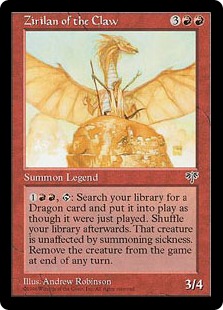
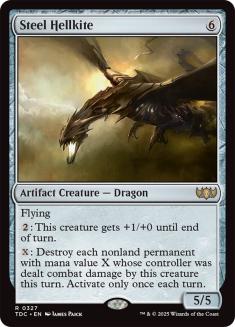
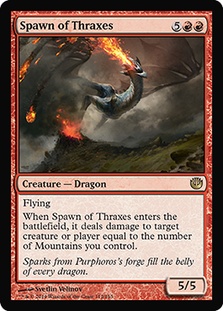

I mean, who doesn’t love the idea of optimizing your deck for “Dragons Matter”? We already have a few utility Dragons here that you want to recur
with Feldon and a ton of sacrifice outlets (or other ways that let you break the end-of-turn trigger), so giving this awesome and oft-forgotten Mirage-era commander a home in your deck will be a good way to spice things up in interesting fashion. Steel Hellkite was going to be a key addition regardless – it can remove enchantments from
play, which is the color’s most glaring weakness in this format – but it doesn’t hurt that it plays into this Dragon-centric subtheme, which also counts as a little extra bonus when adding Spawn of Thraxes as well. Since you’re heavy on the basic lands this will regularly let you get a huge enters-the-battlefield trigger out of it, which of course you can potentially replicate with Feldon on-command.
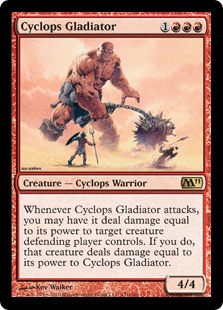
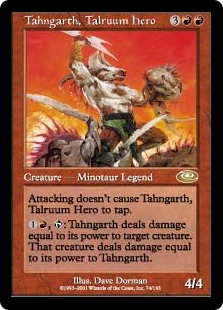
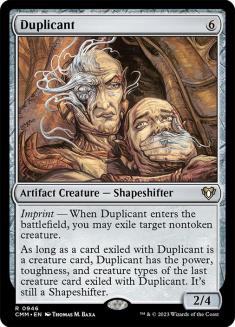
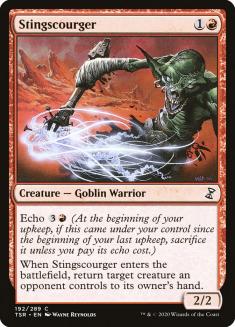
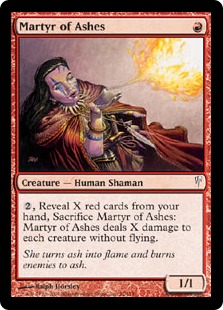

These five are here to bulk up your creature-removal suite; the two fight-based creatures don’t really care if they live or die once they’re Feldon’s constructs,
but they’re actually quite strong for their cost as actual cards that you intend to keep around. We want to play cards on the board early and build pressure while getting some damage in, so their utility with Feldon is at least partially an after-thought (to go with the fact that they’re frankly weaker interactions even if they do theoretically work),
and it’s their efficiency at clearing small threats from the board profitably and without spending mana that we’re relying on.
As far as things we might want to reanimate at crucial times, well – Martyr of Ashes can be a significant sweeper effect that you can recur with Feldon,
though sadly if you need it to be more than a Pyroclasm, it’ll take down your commander as well barring some Darksteel Plate action going on. Both
Duplicant and Stingscourger can answer hard problems that might otherwise stymie us, which makes them very important even if their bodies aren’t the biggest. Stingscourger’s a weak creature but a strong effect, while Duplicant
is just strong all around and a top-shelf removal effect no matter what color you’re playing. Either will let you keep big threats off of the board if
Feldon can copy them, and we want even more of this type of effect than we can actually get our hands on, so it doesn’t really matter if Stingscourger is a
weak creature as it’s doing that work.
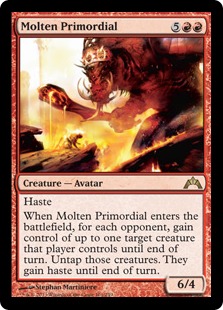
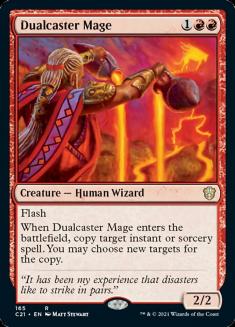
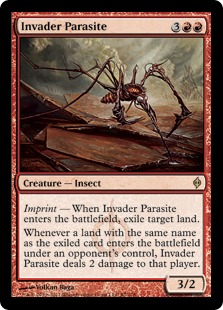

Originally I had put in Goblin Settler, which is a lot of price tag for the amount of effect you’re getting out of it – so instead I had the sane response, picking another card to cut costs – I was half in love with the idea of finally getting to suggest the obscure LD Goblin that I only knew about because of years of Goblinsing people in Legacy, but honestly, you can duplicate this effect in a variety of ways if you don’t want to go down the expensive, obscure
card route. Dwarven Miner and Dwarven
Blastminer were both quite strong in my Godo deck as just a way to keep opponents honest – the threat of the thing generally proved even more effective than spending the mana to actually do it, as it gave people a reason not to ramp too much too fast if I was just going to whack their best land for their trouble – while
Orcish Settlers could potentially be quite disgusting if you have the mana to sink into it. I’m not including it because it’s on the wrong side of ‘fair
game’ in most social circles, but using it responsibly is actually possible, even if it’s really not probable. If you don’t want to spend the extra mana for the Parasite, you can save a mana when playing them the first time and if you go with Petravark or Goblin Gardeners instead, and both work just fine with Feldon if you have a sacrifice outlet to go with them. (As an added bonus, Goblin Gardeners has one of my all-time favorite pieces
of Magic flavor text, but sadly, even that can’t justify playing the card – it makes me smile, but it’s not in the Big Commander Box of Doom.)
I’m a purist when it comes to cheating on mana costs, I am a huge fan of efficiency in Commander even though it seems like such a hugely-inefficient format
to the outside observer – but even as a purist I can’t see putting out $40 for a card you’ll only ever maybe play in Legacy as a one-of if you
play Goblins when you can spend one more mana instead. Invader Parasite it is, since it asks us to jump through the least number of hoops when working it with our Commander and what’s one more mana anyway? We could go pretty deeply down this road if we wanted to – there’s plenty of these sorts of cards available if we want them – but I
think the effect of the seasoning here is about right at the current level, enough to have the effect in a game if you want it but not so much that you
draw nothing but land destruction stuff and people rightfully shun you despite your protestations of, “You are actually going to complain about a Goblin Gardener? Really?”
Dualcaster Mage is the version of Reiterate that you can reanimate, meaning that between it and Mindclaw Shaman you really have the ability to punish
opponents for the spells they’re casting and can hijack power cards in your favor even though that’s a part of the color pie we’re really not supposed to be able to play in and are only somewhat dabbling with here for the sheer novelty factor. And Molten Primordial is added to round out the Zealous Conscripts / Conquering Manticore cycle; it is practically a version of Insurrection that
Feldon can reanimate at will, and it’s especially brutal with your plethora of sacrifice outlets making sure that your opponents don’t get back their
stuff.
Putting it all together, we get the following:
Creatures (34)
- 1 Solemn Simulacrum
- 1 Avalanche Riders
- 1 Thundermare
- 1 Tahngarth, Talruum Hero
- 1 Siege-Gang Commander
- 1 Duplicant
- 1 Zirilan of the Claw
- 1 Bloodshot Cyclops
- 1 Imperial Recruiter
- 1 Ravenous Baboons
- 1 Anarchist
- 1 Flametongue Kavu
- 1 Stalking Vengeance
- 1 Martyr of Ashes
- 1 Bogardan Hellkite
- 1 Stingscourger
- 1 Ingot Chewer
- 1 Spitebellows
- 1 Knollspine Dragon
- 1 Conquering Manticore
- 1 Cyclops Gladiator
- 1 Hoarding Dragon
- 1 Inferno Titan
- 1 Manic Vandal
- 1 Wurmcoil Engine
- 1 Steel Hellkite
- 1 Invader Parasite
- 1 Zealous Conscripts
- 1 Tyrant of Discord
- 1 Beetleback Chief
- 1 Mindclaw Shaman
- 1 Molten Primordial
- 1 Spawn of Thraxes
- 1 Dualcaster Mage
Lands (37)
Spells (28)
- 1 In the Web of War
- 1 Sol Ring
- 1 Goblin Bombardment
- 1 Skullclamp
- 1 Gamble
- 1 Oblivion Stone
- 1 Lightning Greaves
- 1 Spawning Pit
- 1 Mind's Eye
- 1 Grab the Reins
- 1 Insurrection
- 1 Helm of Possession
- 1 Sneak Attack
- 1 Reiterate
- 1 Wild Ricochet
- 1 Vicious Shadows
- 1 Carnage Altar
- 1 Expedition Map
- 1 All Is Dust
- 1 Mimic Vat
- 1 Nim Deathmantle
- 1 Darksteel Plate
- 1 Chaos Warp
- 1 Stranglehold
- 1 Warstorm Surge
- 1 Sundial of the Infinite
- 1 Blasphemous Act
- 1 Vandalblast

As always, for your participation in this week’s edition of Dear Azami you will receive a $20 coupon to the StarCityGames.com online store; you’d
said to shoot for a budget of between $100 and $150 and we’re coming in at $110.91 – though we could have spent far more if we wanted to even without doing
childishly petulant things like suggesting Goblin Settlers just to pad the price count. There’s both serious cost and significant utility to adding
fetchlands and Crucible of Worlds to the deck, and that’s where I’d be starting when building around Feldon of the Third Path since he suggests a
controlling shell. What can I say, control decks love getting extra mana for free. We also could have just blown $30 on a Sensei’s Divining Top – heck, we still could and come out under the top end of your budget – but without those fetchlands adding more ways to clear the top of your deck with fair
regularity, the Top would actually be at its weakest here compared to the shenanigans it usually helps to pull off.
So, with both discipline and reason guiding our selections here, the individual additions were priced as follows:
| Martyr of Ashes | 0.15 |
| Stingscourger | 0.25 |
| Cyclops Gladiator | 0.49 |
| Grab the Reins | 0.49 |
| Invader Parasite | 0.49 |
| Kher Keep | 0.49 |
| Molten Primordial | 0.49 |
| Spawn of Thraxes | 0.49 |
| Sundial of the Infinite | 0.49 |
| Vandalblast | 0.49 |
| Steel Hellkite | 0.75 |
| Mystifying Maze | 0.99 |
| Tahngarth, Talruum Hero | 0.99 |
| Expedition Map | 1.99 |
| Zirilan of the Claw | 1.99 |
| Mimic Vat | 2.99 |
| Reiterate | 2.99 |
| Spinerock Knoll | 2.99 |
| High Market | 5.99 |
| Strip Mine | 5.99 |
| Duplicant | 6.99 |
| Dust Bowl | 7.99 |
| Thawing Glaciers | 7.99 |
| Winding Canyons | 8.99 |
| Oblivion Stone | 11.99 |
| Dualcaster Mage | 14.99 |
| All Is Dust | 19.99 |
That wraps things up for us here today, but I’d like to take the opportunity to offer a gentle reminder to all of our readers – Jess and I would really
like to be covering the other four legendary creatures from Commander 2014 in the next few weeks, and there’s a $20 coupon in it if we pick your
deck, so you’ll be far more likely to get picked in the next month if you send us in a submission based around Ghoulcaller Gisa, Jazal Goldmane, Stitcher
Geralf, or Titania, Protector of Argoth. Those are going to be our next four articles with or without you, and we won’t be returning to our more normal
cycle of working on whatever hits our inbox until mid-December or thereabouts.
If you’d like to submit a deck built around one of those four Commander, send
it to us here. If you’d like to send us a different Commander, that’s fine too, but we won’t be covering it for at least a month.
Want to submit a deck for consideration to Dear Azami? We’re always accepting deck submissions to consider for use in a future article, like Caleb’s Surrak Dragonclaw deck or Kaz’s Gaddock Teeg deck. Only one deck submission will be chosen per article, but being selected for the next edition of Dear Azami includes not just deck advice but also a $20 coupon to StarCityGames.com!
Email us a deck submission using this link here!
Like what you’ve seen? Feel free to explore more of Dear Azami here, in the Article Archives! Feel free to follow Sean on Facebook… sometimes there are extra surprises and bonus content to be found over on his Facebook Fan Page, as well as previews of the next week’s column at the end of the week!
And feel free to check Jess’s own Command of Etiquette column on Hipsters of the Coast for more Commander and casual content.

